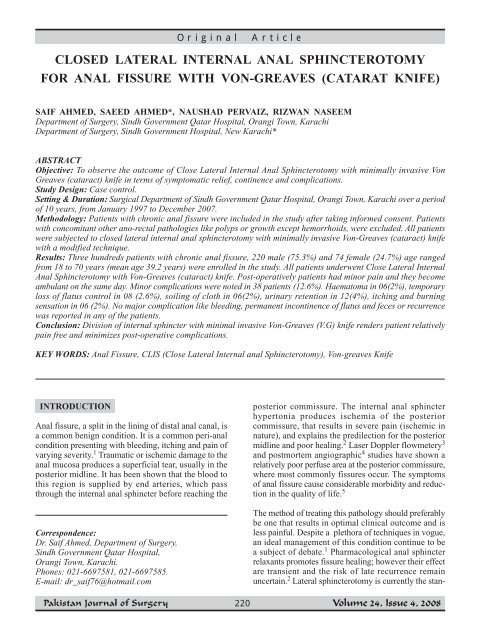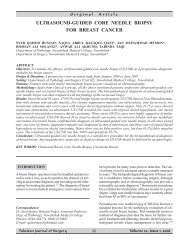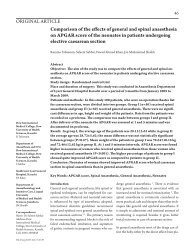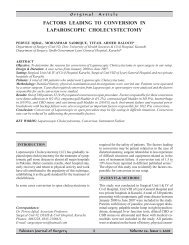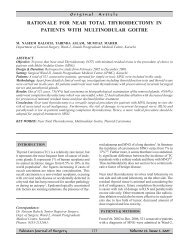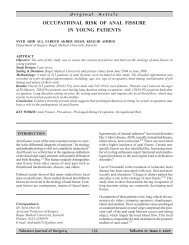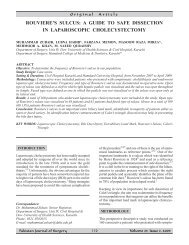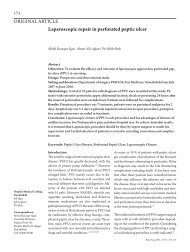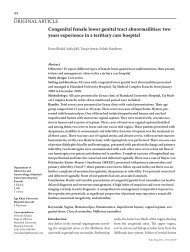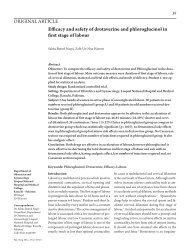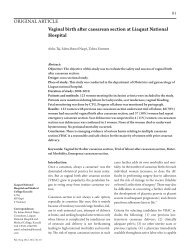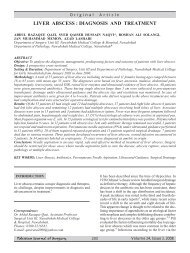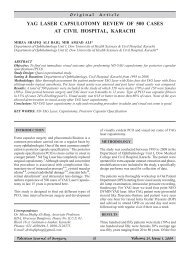Closed lateral internal anal sphincterotomy for anal fissure
Closed lateral internal anal sphincterotomy for anal fissure
Closed lateral internal anal sphincterotomy for anal fissure
Create successful ePaper yourself
Turn your PDF publications into a flip-book with our unique Google optimized e-Paper software.
Original Article<br />
CLOSED LATERAL INTERNAL ANAL SPHINCTEROTOMY<br />
FOR ANAL FISSURE WITH VON-GREAVES (CATARAT KNIFE)<br />
SAIF AHMED, SAEED AHMED*, NAUSHAD PERVAIZ, RIZWAN NASEEM<br />
Department of Surgery, Sindh Government Qatar Hospital, Orangi Town, Karachi<br />
Department of Surgery, Sindh Government Hospital, New Karachi*<br />
ABSTRACT<br />
Objective: To observe the outcome of Close Lateral Internal Anal Sphincterotomy with minimally invasive Von<br />
Greaves (cataract) knife in terms of symptomatic relief, continence and complications.<br />
Study Design: Case control.<br />
Setting & Duration: Surgical Department of Sindh Government Qatar Hospital, Orangi Town, Karachi over a period<br />
of 10 years, from January 1997 to December 2007.<br />
Methodology: Patients with chronic <strong>anal</strong> <strong>fissure</strong> were included in the study after taking in<strong>for</strong>med consent. Patients<br />
with concomitant other ano-rectal pathologies like polyps or growth except hemorrhoids, were excluded. All patients<br />
were subjected to closed <strong>lateral</strong> <strong>internal</strong> <strong>anal</strong> <strong>sphincterotomy</strong> with minimally invasive Von-Greaves (cataract) knife<br />
with a modified technique.<br />
Results: Three hundreds patients with chronic <strong>anal</strong> <strong>fissure</strong>, 220 male (75.3%) and 74 female (24.7%) age ranged<br />
from 18 to 70 years (mean age 39.2 years) were enrolled in the study. All patients underwent Close Lateral Internal<br />
Anal Sphincterotomy with Von-Greaves (cataract) knife. Post-operatively patients had minor pain and they become<br />
ambulant on the same day. Minor complications were noted in 38 patients (12.6%). Haematoma in 06(2%), temporary<br />
loss of flatus control in 08 (2.6%), soiling of cloth in 06(2%), urinary retention in 12(4%), itching and burning<br />
sensation in 06 (2%). No major complication like bleeding, permanent incontinence of flatus and feces or recurrence<br />
was reported in any of the patients.<br />
Conclusion: Division of <strong>internal</strong> sphincter with minimal invasive Von-Greaves (V.G) knife renders patient relatively<br />
pain free and minimizes post-operative complications.<br />
KEY WORDS: Anal Fissure, CLIS (Close Lateral Internal <strong>anal</strong> Sphincterotomy), Von-greaves Knife<br />
INTRODUCTION<br />
Anal <strong>fissure</strong>, a split in the lining of distal <strong>anal</strong> c<strong>anal</strong>, is<br />
a common benign condition. It is a common peri-<strong>anal</strong><br />
condition presenting with bleeding, itching and pain of<br />
varying severity. 1 Traumatic or ischemic damage to the<br />
<strong>anal</strong> mucosa produces a superficial tear, usually in the<br />
posterior midline. It has been shown that the blood to<br />
this region is supplied by end arteries, which pass<br />
through the <strong>internal</strong> <strong>anal</strong> sphincter be<strong>for</strong>e reaching the<br />
Correspondence:<br />
Dr. Saif Ahmed, Department of Surgery,<br />
Sindh Government Qatar Hospital,<br />
Orangi Town, Karachi.<br />
Phones: 021-6697581, 021-6697585.<br />
E-mail: dr_saif76@hotmail.com<br />
220<br />
posterior commissure. The <strong>internal</strong> <strong>anal</strong> sphincter<br />
hypertonia produces ischemia of the posterior<br />
commissure, that results in severe pain (ischemic in<br />
nature), and explains the predilection <strong>for</strong> the posterior<br />
midline and poor healing. 2 Laser Doppler flowmetery 3<br />
and postmortem angiographic 4 studies have shown a<br />
relatively poor perfuse area at the posterior commissure,<br />
where most commonly <strong>fissure</strong>s occur. The symptoms<br />
of <strong>anal</strong> <strong>fissure</strong> cause considerable morbidity and reduction<br />
in the quality of life. 5<br />
The method of treating this pathology should preferably<br />
be one that results in optimal clinical outcome and is<br />
less painful. Despite a plethora of techniques in vogue,<br />
an ideal management of this condition continue to be<br />
a subject of debate. 1 Pharmacological <strong>anal</strong> sphincter<br />
relaxants promotes <strong>fissure</strong> healing; however their effect<br />
are transient and the risk of late recurrence remain<br />
uncertain. 2 Lateral <strong>sphincterotomy</strong> is currently the stan-
dard surgical treatment <strong>for</strong> <strong>fissure</strong> in ano, which results<br />
in healing of 90% of cases. 1 However <strong>sphincterotomy</strong><br />
also carries a significant risk of incontinence. Traditional<br />
surgical procedures; manual <strong>anal</strong> dilatation or <strong>internal</strong><br />
<strong>lateral</strong> <strong>sphincterotomy</strong>, have been commonly used to<br />
reduce the hypertonia of the <strong>internal</strong> <strong>anal</strong> sphincter, but<br />
they do carry risk of irreversible impairment of <strong>anal</strong><br />
continence. 6<br />
Open <strong>sphincterotomy</strong> comprises of division of the<br />
<strong>internal</strong> sphincter up to the level of the dentate line, a<br />
more conservative division could lead to a lower<br />
incontinence rate with an equivalent healing rate. 7<br />
<strong>Closed</strong> Lateral Internal Sphincterotomy (CLIS), with<br />
the minimally invasive Von-Greaves (cataract) knife<br />
with a modified technique have been the most favored<br />
surgical procedure <strong>for</strong> healing in Anal Fissure. 8 In this<br />
study it was observed the outcome of Close Lateral<br />
Internal Anal Sphincterotomy with Von-Greaves<br />
(cataract) knife in terms of symptomatic relief, continence<br />
and complications has good patient’s acceptance.<br />
METHODOLOGY<br />
This case control study was conducted at the surgical<br />
unit of Sindh Government Qatar Hospital Orangi Town,<br />
Karachi, from January 1997 to December 2007. Three<br />
hundred patients with chronic <strong>anal</strong> <strong>fissure</strong> were enrolled<br />
in the study after taking in<strong>for</strong>med consent. Patient associated<br />
with other ano-rectal pathologies like prolepses,<br />
growth or polyp except hemorrhoids were excluded.<br />
Eight (2.7%) had <strong>anal</strong> stenosis due to chronicity of <strong>fissure</strong><br />
were also included in the study. If proctocopy was<br />
not possible at the first visit because of pain, it was<br />
completed at a subsequent visit after advising patient<br />
to take laxative, hot sitz bath and 0.5% glyceryl trinitrate.<br />
Chronic <strong>anal</strong> <strong>fissure</strong> was defined as symptoms lasting<br />
<strong>for</strong> more than 8 weeks, with horizontal muscle fibres<br />
showing at the <strong>fissure</strong> base and/or the presence of a<br />
sentinel tag. Pre-operative preparation was started 24<br />
hours be<strong>for</strong>e surgery.<br />
221<br />
were unfit <strong>for</strong> that. Anesthetist was asked to induce<br />
light general anesthesia so that sphincter tone is preserved<br />
and a clear demarcation between <strong>internal</strong> sphincter and<br />
ano rectal ring can be felt per rectally. Injection 2%<br />
lignocain 2cc injected at 7 o clocks position, 1 cm above<br />
the <strong>anal</strong> verge be<strong>for</strong>e inserting the cataract knife. 8<br />
Sentinel piles were not excised in most of the patients.<br />
All patients were discharged after 24 hours on Tab.<br />
Metranidazole 400mg TDS and Tab. Diclofenac Sodium<br />
50mg BD <strong>for</strong> 5 days and sitz bath twice daily. Laxatives<br />
were used <strong>for</strong> 3 days. Patients were followed up weekly<br />
<strong>for</strong> one month and than 3 monthly <strong>for</strong> a period of 12<br />
months. Specific question were asked regarding leakage<br />
of fluid, feces or flatus as well as recurrence of<br />
symptoms. Browning and Park’s classification used <strong>for</strong><br />
post-operative incontinence of feces 9 (Table I).<br />
RESULTS<br />
Three hundreds patients with chronic <strong>anal</strong> <strong>fissure</strong>, 220<br />
male (73.3%) and 8 female (26.7%) age ranged from<br />
18-70 years (mean age 39.2 years) were included in the<br />
study. All patients underwent Close Lateral Internal<br />
Anal Sphincterotomy with Von-Greaves (cataract) knife.<br />
The <strong>fissure</strong> was posterior in 235(76.7%) of patients and<br />
anterior in 43(14.3%) while both anterior and posterior<br />
in 22(7.3%) of patients.<br />
Most of patients 185(61.7%) were pain free on routine<br />
<strong>anal</strong>gesics within 24 hours while 109(36.3%) after 48<br />
hours postoperatively. Six patients (2%) were discharged<br />
with mild but tolerable pain. No major complication<br />
like permanent loss of flatus and feces control or<br />
recurrence was noted. How-ever minor complications<br />
were noted in 38 patients (Table II). Temporary loss of<br />
control over flatus and faeces was noted in 8 patients<br />
(2.7%) and soiling of cloth in 6(2%) patients. They<br />
improved from category C of Browning and Parks<br />
classification <strong>for</strong> incontinence to category A spontaneously<br />
without any further treatment.<br />
DISCUSSION<br />
In this study male were affected more than female and<br />
Table I. Browning and Park’s classification <strong>for</strong> incontinence9 CLIS per<strong>for</strong>med under general anesthesia in lithotomy<br />
position using von-greaves (cataract) knife. General<br />
anesthesia was preferred <strong>for</strong> all patients except few who<br />
Category A<br />
Category B<br />
Category C<br />
Category D<br />
Normal continence except occasional lack of fecal control<br />
Regular incontinence of flatus with usual continence of solid liquid stool<br />
Intermittent small volume faecal leakage with usual incontinence of flatus but<br />
acceptable continence of solid stool<br />
Gross incontinence of solid and liquid stool
it showed that CLIS with Von-Greaves knife is safe<br />
procedure, most of the patients remain free of pain.<br />
Although it was associated with minor complications<br />
but all were reversible. Syed 11 reported a complication<br />
rate of 17.8% after open technique. There was no demonstrable<br />
difference between open verses closed technique<br />
<strong>for</strong> <strong>sphincterotomy</strong> in different studies, 12,13 where as<br />
in a study conducted by Gargia, 14 statistically significant<br />
difference was noted <strong>for</strong> soiling of under garments,<br />
26.7% in open verses 16.1% in closed. In this study<br />
only 2% of patients experienced soiling of underclothes.<br />
CLIS with Von-Greaves knife has a flat of blade of just<br />
2 mm in size. Primary hemorrhage was noted in only<br />
6 patients (2%) which were controlled by pressure.<br />
Haematoma was not observed in any case. Aysan 15<br />
reported 17.6% post operative external bleeding following<br />
Lateral Internal Sphincterotomy. A recent comparative<br />
study of <strong>lateral</strong> <strong>internal</strong> <strong>sphincterotomy</strong> versus local<br />
0.2% glyceryl trinitrate ointment <strong>for</strong> the treatment of<br />
chronic <strong>anal</strong> <strong>fissure</strong> showed that surgical <strong>sphincterotomy</strong><br />
was significantly more effective in providing pain relief<br />
Table II. Complications of CLIS<br />
Complications No. (%)<br />
Urinary retention<br />
Temporary loss of flatus<br />
Soiling of cloths<br />
Itching and burning<br />
Primary hemorrhage<br />
Haematoma<br />
Infection<br />
Permanenet incontinence<br />
Delayed healing > 60 days<br />
Recurrence<br />
12 (4)<br />
8 (2.7)<br />
6 (2)<br />
6 (2)<br />
6 (2)<br />
0<br />
0<br />
0<br />
0<br />
0<br />
222<br />
and was associated with significantly better <strong>fissure</strong><br />
healing rates at 6 weeks and 10 weeks. 16 There were<br />
substantial problems with compliance in ointment group<br />
related to slow healing and longer time needed <strong>for</strong> symptomatic<br />
relief. Minor incontinence was 6% in <strong>sphincterotomy</strong><br />
group and none in ointment group (p > 0.05).<br />
Considering early symptomatic relief, rapid <strong>fissure</strong><br />
healing and better patient compliance surgical <strong>sphincterotomy</strong><br />
is the treatment of choice <strong>for</strong> chronic <strong>anal</strong> <strong>fissure</strong>.<br />
16 A meta-<strong>anal</strong>ysis done by Sajib 17 comparing surgical<br />
vs chemical <strong>sphincterotomy</strong> using botulinum toxin<br />
<strong>for</strong> the treatment of chronic <strong>anal</strong> <strong>fissure</strong> showed that<br />
there was a higher complication rate (Risk ratio 14.54,<br />
P
2. Marion J, Scholfield J H. Anal Fissure and chemical<br />
Sphincterotomy. Recent advances in Surg 2001;<br />
24: 115-24.<br />
3. Scouten W R, Briel J W, Auwerda J J. Relationship<br />
between <strong>anal</strong> pressure and anodermal blood flow:<br />
The vascular pathogenesis of Anal Fissure. Dis<br />
Colon Rectum 1994; 37: 664-9.<br />
4. Lund J N, Binch C, McGrath J, Sparen R A, Scholfield<br />
J H. Topographical distribution of blood supply<br />
to the <strong>anal</strong> c<strong>anal</strong>. Br J Surg 1999; 88: 496-8.<br />
5. Sailer M, Bussen D, Dubes E S, Fuchs K H, Theeda<br />
A. Quality of life in patients with benign anorectal<br />
disorders. Br J Surg 1998; 89: 1716-9.<br />
6. Gracia A, Belmonk M C, Pervez J J, Jensen L,<br />
Madoff R D, Wong W D. Incontinence after <strong>lateral</strong><br />
<strong>internal</strong> <strong>sphincterotomy</strong> , anatomic and functional<br />
evaluation. Dis Colon Rectum 1998; 41: 423-7.<br />
7. Garcea G, Sutton C, Mansoori S, Llyod T, Thomas<br />
M. Results following conservative <strong>lateral</strong> <strong>sphincterotomy</strong><br />
<strong>for</strong> the treatment of chronic <strong>anal</strong> <strong>fissure</strong>.<br />
Colorectal Dis 2003; 5(4): 311.<br />
8. Keighley M R B. Anorectal Disorders. In: Fischer<br />
JE. Mastery of Surgery. 5th edn. Lippincott Williams<br />
and Wilkins, Philadelphia. 1608-27.<br />
9. Browning G G P. Post <strong>anal</strong> repair <strong>for</strong> neuropathic<br />
faecal incontinence, correlation of clinical results<br />
and <strong>anal</strong> c<strong>anal</strong> pressure. Br J Surg 1999;86: 651-5.<br />
10. Umer S A, Salim M. Effectiveness of topical diltiazem<br />
versus glyceryl trinitrate in the treatment of<br />
223<br />
chronic <strong>anal</strong> <strong>fissure</strong>s. Pak J Surg 2003; 19: 62-7.<br />
11. Syed S A, Waris S, Ahmed E, Saeed N, Ali B. Lateral<br />
<strong>internal</strong> <strong>anal</strong> <strong>sphincterotomy</strong> <strong>for</strong> <strong>anal</strong> <strong>fissure</strong>:<br />
with or without associated anorectal procedures. J<br />
Coll Physcians Surg Pak 2003; 13(8): 436-9.<br />
12. Liratzopoulos N, Efremidou E I, Papageorgiou M<br />
S. Lateral subcutaneous <strong>internal</strong> <strong>sphincterotomy</strong> in<br />
the treatment of chronic <strong>anal</strong> <strong>fissure</strong>; our exposure.<br />
J Gastrointestinal Liver Dis 2006; 15(2): 143-7.<br />
13. Mentes B B, Tezcaner T, Yilmaz U. Results of <strong>lateral</strong><br />
<strong>internal</strong> <strong>sphincterotomy</strong> <strong>for</strong> chronic <strong>anal</strong> <strong>fissure</strong><br />
with particular reference to quality of life. Dis Colon<br />
Rectum 2006; 49(7): 1045-51.<br />
14. Gargia A J, Belmonte C, Wong W D. Open verses<br />
closed <strong>sphincterotomy</strong> <strong>for</strong> chronic <strong>anal</strong> <strong>fissure</strong>: long<br />
term results. Dis Colon Rectum 1996; 39: 440-3.<br />
15. Aysan E, Aren A, Ayer E. A prospective randomized<br />
controlled trial of primary wound closure after<br />
<strong>lateral</strong> <strong>internal</strong> <strong>sphincterotomy</strong>. Am J Surg 2004;<br />
187(2): 291-4.<br />
16. Siddique M I, Murshed K M, Majid M A. Comparative<br />
study of <strong>lateral</strong> <strong>internal</strong> <strong>sphincterotomy</strong> versus<br />
local 0.2% glyceryl trinitrate ointment <strong>for</strong> the treatment<br />
of chronic <strong>anal</strong> <strong>fissure</strong>. Bangladesh Med Res<br />
Counc Bull 2008; 34(1): 12-5.<br />
17. Sajid M S, Hunte S, Hippolyte S, Kiri V A, Maringe<br />
C, Baig M K. Comparison of surgical versus chemical<br />
<strong>sphincterotomy</strong> using botulinum toxin <strong>for</strong> the<br />
treatment of chronic <strong>anal</strong> <strong>fissure</strong>: a meta-<strong>anal</strong>ysis.<br />
Colorectal Dis 2008; 10(6): 547-52.


